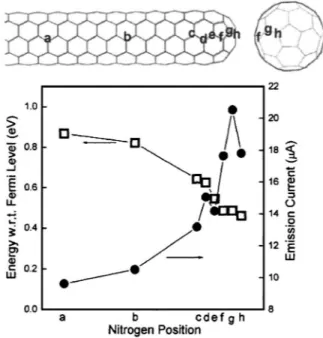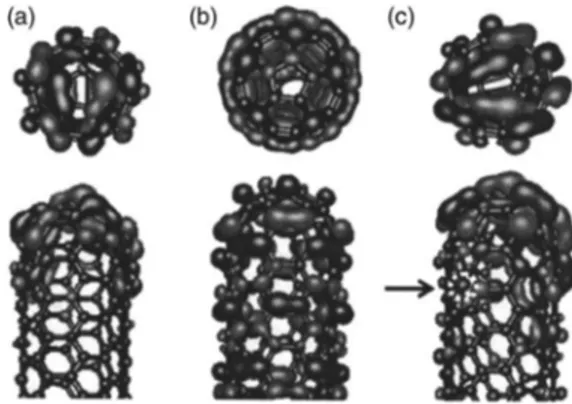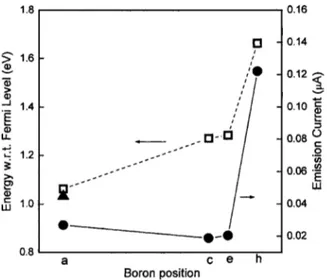Appl. Phys. Lett. 88, 093122 (2006); https://doi.org/10.1063/1.2180444 88, 093122
© 2006 American Institute of Physics.
Field emission of doped carbon nanotubes
Cite as: Appl. Phys. Lett. 88, 093122 (2006); https://doi.org/10.1063/1.2180444Submitted: 24 June 2005 . Accepted: 18 January 2006 . Published Online: 03 March 2006 Hyo-Shin Ahn, Kwang-Ryeol Lee, Doh-Yeon Kim, and Seungwu Han
ARTICLES YOU MAY BE INTERESTED IN
Effect of substitutional atoms in the tip on field-emission properties of capped carbon nanotubes
Field emission of doped carbon nanotubes
Hyo-Shin Ahna兲 and Kwang-Ryeol Leeb兲Future Technology Research Division, Korea Institute of Science and Technology, Seoul 136-791, Korea Doh-Yeon Kim
School of Materials Science and Engineering, Seoul National University, Seoul 151-742, Korea Seungwu Hanc兲
Department of Physics and Division of Nano Science, Ewha Womans University, Seoul 120-750, Korea 共Received 24 June 2005; accepted 18 January 2006; published online 3 March 2006兲
We calculated field-emission currents from nitrogen- and boron-doped single-walled 共5,5兲 carbon nanotubes by integrating time-dependent Schrödinger equations. Nitrogen doping increased the emission current owing to a shift in the energy level of a localized state to the Fermi level, and the creation of coupled states that have characteristics of both localized and extended states. On the other hand, boron doping had an opposite effect on the electronic structure by increasing the energy level of the localized state. The calculated emission currents of the boron-doped carbon nanotube fluctuated depending on the doping site and the external electric field. © 2006 American Institute of
Physics. 关DOI:10.1063/1.2180444兴
Field emission behavior of carbon nanotubes has been actively studied for possible applications as novel types of displays or light sources. It is an intriguing idea to engineer the field-emission properties of carbon nanotubes by doping the nanotube with atoms of nitrogen共N兲 or boron 共B兲, which have electronic properties are similar to those of carbon atoms.1–6Recently, N-doped carbon nanotubes, also referred to as CNxnanotubes, have attracted much attention because the doping radically modifies the electrical properties of the carbon nanotubes. High resolution electron-energy-loss-spectroscopy 共EELS兲 reveals signatures of a covalent C–N bond, suggesting that N atoms substitutionally replace car-bon atoms. On the other hand, boron doping is known to be more difficult due to the ease of formation of the B4C phase 3
and/or the evolution of disordered structure caused by in-terstitial incorporation of B.7 By contrast, doping with a small amount of boron tends to improve the crystallinity of the nanotube.8
Compared with pristine carbon nanotubes, the field emission behavior of N-or B-doped nanotubes has been in-tensely studied.9–11In most cases, nitrogen doping has been found to increase the field emission current, even though the mechanism for this enhanced emission is yet to be under-stood. On the other hand, the effect of boron doping on the field emission is somewhat unclear.9,10The electronic struc-ture of the tip region has been theoretically calculated, and the field-emission properties discussed in terms of the den-sity of states near the Fermi level or local work function. However, one should note that the actual emission current depends strongly on the local electric field, which could be affected by the doping configuration. Furthermore, the tun-neling barrier experienced by the emitting state is difficult to estimate from the electronic structure in the unbiased
condi-tion. A more realistic approach to evaluate the actual emis-sion current is thus required for a complete understanding of the emission behavior.
In our work, we employed a “first-principles” method to calculate the emission current of N- and B-doped carbon nanotubes. Due to limited computational resources, we stud-ied the emission behavior of a small-radius, single-walled 共5,5兲 carbon nanotube. We note that multiwalled carbon nanotubes are more frequently studied in experiments. We considered only the tip region where the applied electric field is greatest, and hence where most field emission occurs. Fig-ure 1 shows the model system of the共5,5兲 carbon nanotube 共diameter ⬃7 Å, length ⬃30 Å兲 used in our work. The
po-a兲Also at: School of Materials Science and Engineering, Seoul National
Uni-versity, Seoul, 151-742, Korea.
b兲Author to whom the correspondence should be addressed; electronic mail:
krlee@kist.re.kr
c兲Author to whom correspondence should be addressed; electronic mail:
hansw@ewha.ac.kr
FIG. 1. The model共5,5兲 nanotube used in the calculation, and the calculated emission current for N-doped carbon nanotubes with an external electric field of 0.7 V / Å. The letters indicate the atomic sites for replacing carbon with nitrogen atoms. The open squares show the energy of the localized states relative to the Fermi energy. The solid circle shows the emission current calculated for each doping site.
APPLIED PHYSICS LETTERS 88, 093122共2006兲
sitions of the doping elements are indicated by letters. In the case of the B-doped nanotube, we used a longer tube of length 40 Å to minimize the finite-size effect.12 The front end of the nanotube was closed with a hemisphere of C60and the carbon atoms in the other end were passivated with hy-drogen atoms.
To calculate the field-emission current of nanotubes un-der an external electric field, we used the first-principles method proposed by Han et al., which has been applied to several carbon systems.12,13The computations involved two steps. The first step was a self-consistent calculation using the localized atomic orbital under an external electric field applied along the nanotube. In the second step, the basis set was switched to plane waves, and the electrons tunneling out to the vacuum were monitored by integrating the time-dependent Schrödinger equation. We used a fourth-order split-operator method to separate kinetic and potential terms of the time-evolution operator in an exponential form. A time step of 0.0024 fs was chosen for temporal evolutions. The size of supercell was chosen to be 20⫻20⫻80 Å3, which is large enough to avoid interaction with adjacent repeated cells. Various external electric fields in the range 0.3– 1.2 V / Å were applied, which corresponded to local electric fields at the tip end ranging from about 0.5 to 1.5 V / Å. In real situations, empty states of emitted electrons should be replenished by extended states in nano-tubes to form a closed circuit macroscopically. Since the transition time from extended states to localized states in the tip region is much shorter than the tunneling time 共femtosec-ond versus picosec共femtosec-ond兲, the overall emission current would be dictated by tunneling rates into vacuum states.
The plot in Fig. 1 shows the variation of emission cur-rent as a function of the nitrogen doping position for an external electric field of 0.7 V / Å. The emission current of the pristine nanotube was 8.7A. The total energies de-pended on the doping position of nitrogen atoms; the substi-tuted nitrogen atom prefers sites on the tip end to those on the tube body by 0.3 eV, which implies the nitrogen induces local distortion or defects. Two distinct electronic states ex-isted in the nanotube: the localized state and the extended state.14 Electron emission from the localized state plays a major role in the total emission current from pure carbon nanotubes.13In the N-doped carbon nanotubes, the emission currents were strongly dependent on the doping position; ni-trogen doping in the cap region increased the emission cur-rent by more than 100%, whereas nitrogen doping in the side wall had a small effect on the emission current. From a de-tailed analysis of the band-decomposed emission, we found two factors contributing to the increase in emission currents as a result of nitrogen doping. First, addition of nitrogen into a nanotube changed the energy level of the localized states. For the undoped共5,5兲 nanotube, the localized state existed about 1 eV above the Fermi level. The localized state shifted down to the Fermi level as the position of the nitrogen dop-ing approached the tip 共see open square data in the plot of Fig. 1兲. The decrease in energy was due to an effectively attractive potential of nitrogen atoms.15 As the localized states were closer to the Fermi level, occupancy of the local-ized states increased, resulting in a larger emission probabil-ity. On the other hand, the Fermi levels evaluated from the vacuum level were −4.53 eV and −4.36± 0.02 eV for un-doped and N-un-doped nanotubes, respectively. The small in-crease in the emission current that was observed for nitrogen
doping in the sidewall may come from this slight decrease of the value of the work function.
The second effect of nitrogen doping was the creation of coupled states with mixed properties of the localized and extended states共see Fig. 2兲. We found that the coupled states were more prominent when the nitrogen doping was near the tip region. The presence of the nitrogen atoms broke the rotational symmetry of the nanotube so that states with dif-ferent azimuthal angular momentum, such as the localized and extended states, could be coupled. Figure 3 shows the emission current of each state for various values of the ex-ternal electric field. The emission current from the coupled states was similar to that from the localized state, since the states were substantially exposed to the highest electric field. The coupled states intermixed with the localized states in-creased the number of states with a large emission capability. The boron doping had an effect that differed from that of the nitrogen doping. We found that the coupled states ob-served in the N-doped nanotube did not occur for boron dop-ing. Furthermore, boron doping around the cap region raised the energy level of the localized state since the boron atoms were effectively repulsive for thestates.16The data plotted as open squares in Fig. 4 show that the boron atoms in the FIG. 2. 共Color online兲 The spatial distribution 共front and side views兲 of three distinct types of states contributing to the emission current of N-doped carbon nanotubes. Different shades indicate the sign of the wave function. 共a兲 Localized state, 共b兲 extended state, and 共c兲 coupled state. The position of the doped N atom is indicated by an arrow in共c兲.
FIG. 3. The state-resolved emission current of N-doped carbon nanotubes for various external electric fields.
cap region pushed up the energy level of the localized state by as much as 0.8 eV. Larger external fields were thus re-quired to shift the localized level down to the Fermi level and make them contribute to the emission current. This ac-counts for the reduced emission current in Fig. 4 共closed circle data兲. However, it was noticeable that the total emis-sion current increased significantly when the boron atom was substituted at the h site. This is in stark contrast to the argu-ment that connects the position of the localized states with the emission currents. Inspection of the partial density of states of carbon nanotubes revealed that there was another localized state about 0.9 eV below the Fermi level. In the pristine or N-doped nanotubes, this state was too low in en-ergy to contribute to the emission current. However, under the influence of the boron atoms at the tip, the energy level of this state moved closer to the Fermi level, resulting in a significant reduction in the tunneling length. One should note that this behavior was highly sensitive to the doping position and to the external electric field. For example, at a higher electric field of 0.5 V / Å, doping at the h site did not result in the current enhancement. Regarding the relative stability, bo-ron doping has negligible site dependence within 0.1 eV fluctuation, indicating that the boron atoms would be ran-domly distributed in real situations. The sensitivity to both
the doping position and the external electric field explains the two opposing experimental results on B-doped nanotubes.9,10
In summary, we found that enhanced electron emission by nitrogen doping was related to the shift of the localized state to the Fermi level, and the significant contribution of the coupled state near the Fermi level. Boron doping may result in the fluctuation of the emission current because the localized state at the deep level may play a role in the emis-sion, depending on experimental conditions, such as nano-tube preparation and the electric field applied for electron emission.
H.S.A. and K.R.L. were supported by the Creativity Re-search Program of Korea Institute of Science and Technol-ogy. S.H. was supported by the Korea Research Foundation Grant No. KRF-2004-005-C00057.
1Z. Weng-Sieh, K. Cherrey, Nasreen G. Chopra, X. Blase, Yoshiyuki
Miyamoto, Angel Rubio, Marvin L. Cohen, Steven G. Louie, A. Zettl, and R. Gronsky, Phys. Rev. B 51, 11229共1995兲.
2M. Terrones, N. Grobert, J. Olivares, J. P. Zhang, H. Terrones, K.
Kordatos, W. K. Hsu, J. P. Hare, P. D. Townsend, K. Prassides, A. K. Cheetham, H. W. Kroto, and D. R. M. Walton, Nature共London兲 388, 52 共1997兲.
3M. Terrones, A. Jorio, M. Endo, A. M. Rao, Y. A. Kim, T. Hayashi, H.
Terrones, J.-C. Charlier, G. Dresselhaus, and M. S. Dresselhaus, Comput. Electr. Eng. 7, 30共2004兲.
4W.-Q. Han, P. Kohler-Redlich, T. Seeger, F. Ernst, M. Rühle, N. Grobert,
W.-K. Hsu, B.-H. Chang, Y.-Q. Zhu, H. W. Kroto, D. R. Walton, M. Terrones, and H. Terrones, Appl. Phys. Lett. 77, 1807共2000兲.
5T.-Y. Kim, K.-R. Lee, K. Y. Eun, and K.-H. Oh, Chem. Phys. Lett. 372,
603共2003兲.
6S. Trasobares, O. Stéphan, C. Colliex, W. K. Hsu, H. W. Kroto, and D. R.
M. Walton, J. Chem. Phys. 116, 8966共2002兲.
7C. T. Hach, L. E. Jones, C. Crossland, and P. A. Thrower, Carbon 37, 221
共1999兲.
8Ph. Redlich, J. Loeffler, P. M. Ajayan, J. Bill, F. Aldinger, and M. Rühle,
Chem. Phys. Lett. 260, 465共1996兲.
9J.-C. Charlier, M. Terrones, M. Baxendale, V. Meunier, T. Zacharia, N. L.
Rupesinghe, W. K. Hsu, N. Grobert, H. Terrones, and G. A. J. Amaratunga, Nano Lett. 2, 1191共2002兲.
10L. H. Chan, K. H. Hong, D. Q. Xiao, W. J. Hsieh, S. H. Lai, H. C. Shih,
T. C. Lin, F. S. Shieu, K. J. Chen, and H. C. Cheng, Appl. Phys. Lett. 82, 4334共2003兲.
11G. Zhang, W. Duan, and B. Gu, Appl. Phys. Lett. 80, 2589共2002兲. 12S. Han and J. Ihm, Phys. Rev. B 66, 241402共R兲 共2002兲.
13S. Han, M. H. Lee, and J. Ihm, Phys. Rev. B 65, 085405共2002兲. 14R. Tamura and M. Tsukada, Phys. Rev. B 52, 6015共1995兲.
15S. Baroni, A. Dal Corso, S. de Gironcoli, and P. Giannozzi,
http://www.pwscf.org.
16T. Yoshioka, H. Suzuura, and T. Ando, J. Phys. Soc. Jpn. 72, 2656共2003兲.
FIG. 4. The emission current of B-doped carbon nanotubes for an external electric field of 0.3 V / Å. The boron positions are shown in Fig. 1. The open squares show the energy of the localized states relative to the Fermi energy. The solid circles show the emission current calculated for each doping site. The triangle data indicate the energy of the localized state of the pristine carbon nanotube. The emission current of the pristine nanotube is 1.03A.


